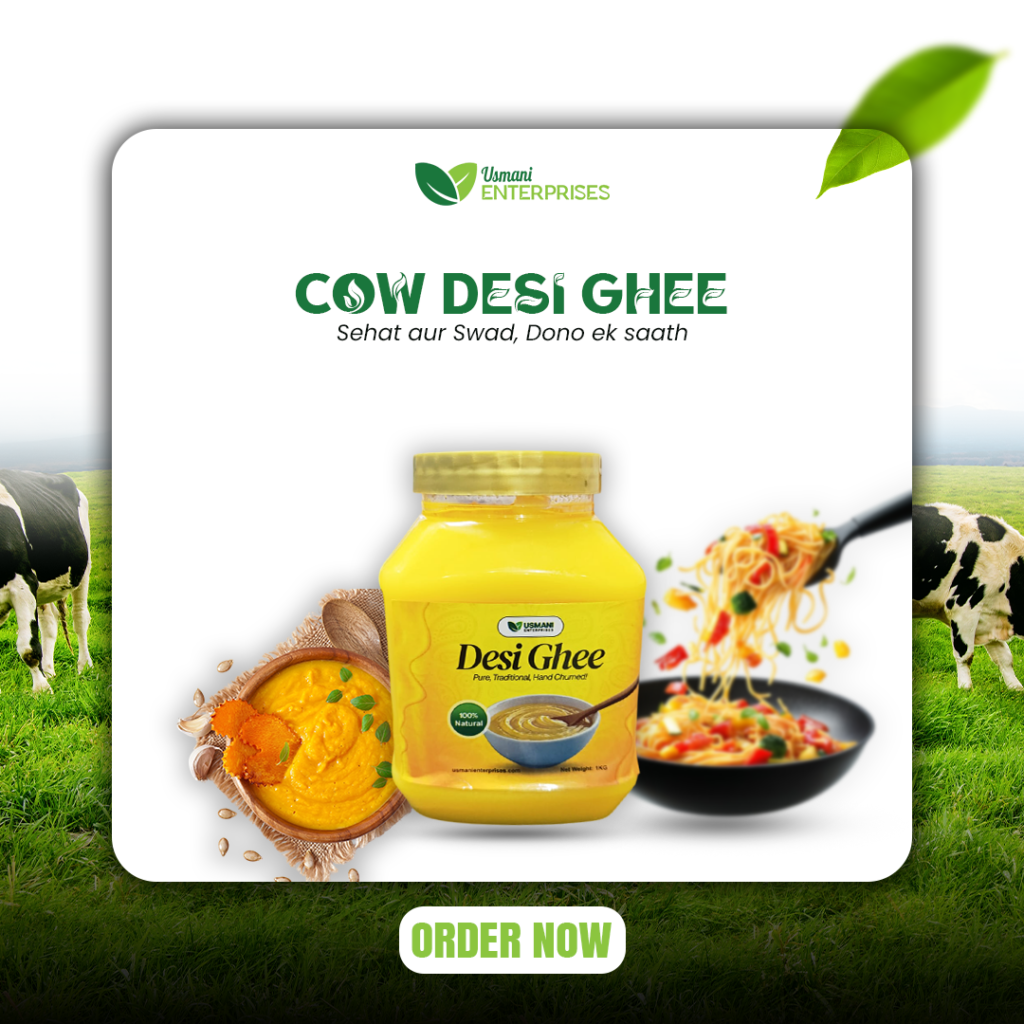Desi Ghee Benefits, Nutrition, and Everyday Use (Complete Guide)
Desi Ghee — Benefits, Nutrition, and Cooking Guide Usmani Enterprisese
Discover the 7 science-backed benefits of desi ghee. Learn about its nutrition, cooking uses, and how to choose authentic ghee for your health and kitchen.
desi-ghee-benefits-nutrition-guide
What is Desi Ghee?
Desi ghee is a type of clarified butter traditionally made by simmering butter until the water evaporates and the milk solids caramelize, leaving behind a rich, nutty, golden liquid. Unlike regular clarified butter, desi ghee is cooked slightly longer, which gives it a stronger aroma and deeper flavor.
Nutrition at a Glance (per 100 g / 1 tbsp)
- Calories: ~870 kcal per 100 g (≈130 kcal per tbsp)
- Total Fat: ~99 g (mostly saturated + monounsaturated fats)
- Vitamins: Rich in Vitamin A, E, and K2
- Fatty Acids: Contains omega-3s, conjugated linoleic acid (CLA), and short-chain fatty acids
Note: 1 tablespoon (~15 g) contains about 130 kcal and 15 g fat.
7 Science-Backed Benefits of Desi Ghee
- Great for High-Heat Cooking
With a smoke point of ~485°F (252°C), ghee is ideal for frying, sautéing, and roasting. - Low in Lactose & Casein
Since milk solids are removed during the process, many lactose-intolerant people tolerate ghee better than butter. - Supports Digestion & Gut Health
Ghee is a natural source of butyrate — a short-chain fatty acid linked to gut health and anti-inflammatory properties. - Skin & Healing Properties
Ayurveda and modern studies highlight ghee’s role in moisturizing skin and aiding in wound healing. - Rich Flavor Enhancer
Adds depth, aroma, and nutty flavor to traditional dishes. - Long Shelf Life
When stored properly, ghee remains stable for months without refrigeration. - Rising Market Demand
The global and Pakistani ghee markets are growing steadily due to consumer demand for authentic, traditional, and natural fats.

How to Choose Authentic Desi Ghee
- Source of Milk: Prefer ghee made from grass-fed cow or buffalo milk.
- Color & Aroma: Should be golden with a nutty aroma.
- No Additives: 100% pure milk fat — no hydrogenated oils or artificial flavors.
- Packaging: Airtight jars with batch number and expiry date.
- Label Check: Clear nutrition facts and manufacturer information.
Cooking Tips & Everyday Use
- Frying: Ideal for parathas, curries, and shallow frying.
- Finishing Touch: Add a spoon to lentils, roti, or rice for flavor.
- Baking: Can replace butter in cookies and pastries for a nutty twist.
- Storage Tip: Keep in an airtight jar, use a dry spoon, and avoid moisture.
Health Precautions
While ghee offers several benefits, it is calorie-dense and should be consumed in moderation. If you have high cholesterol, heart disease, or other metabolic concerns, consult your doctor before adding large amounts to your diet.
Desi Ghee in the Market
The desi ghee market is expanding worldwide, and in Pakistan, it continues to thrive due to cultural preference, rising awareness of natural foods, and the shift towards traditional healthy fats. Marketing terms like “farm-fresh,” “grass-fed,” and “authentic handmade ghee” attract health-conscious consumers.
Conclusion
Desi ghee is more than just a cooking ingredient — it’s a blend of tradition, nutrition, and wellness. Whether you’re frying, baking, or simply spreading it on your roti, ghee adds a unique richness. Choose authentic, additive-free ghee for maximum health benefits.
Usmani Enterprises offers 100% pure, farm-sourced desi ghee — order now and bring authenticity to your kitchen
